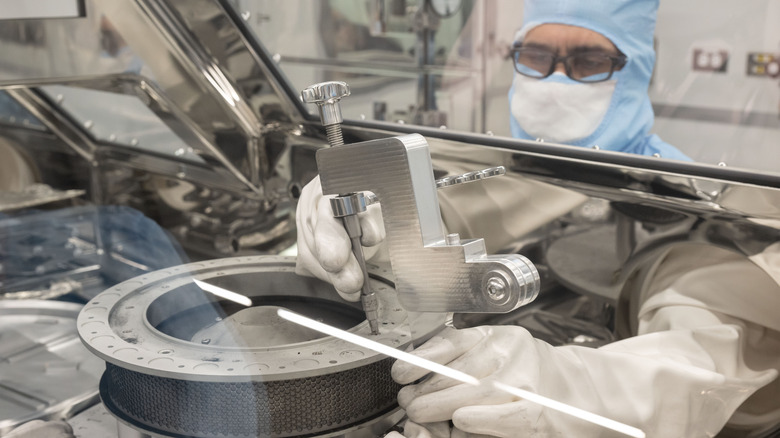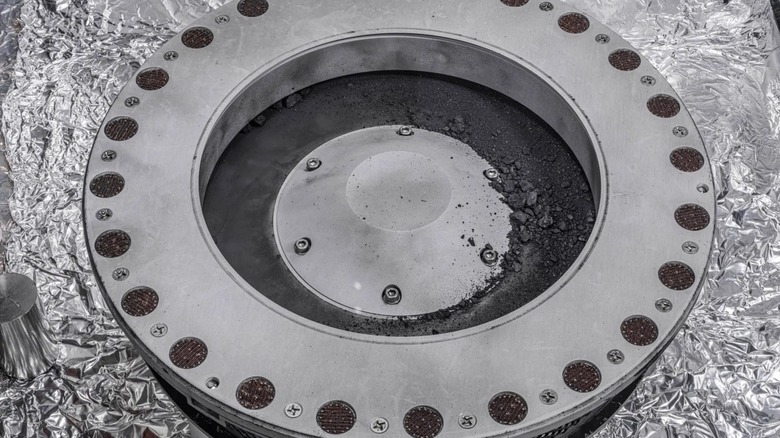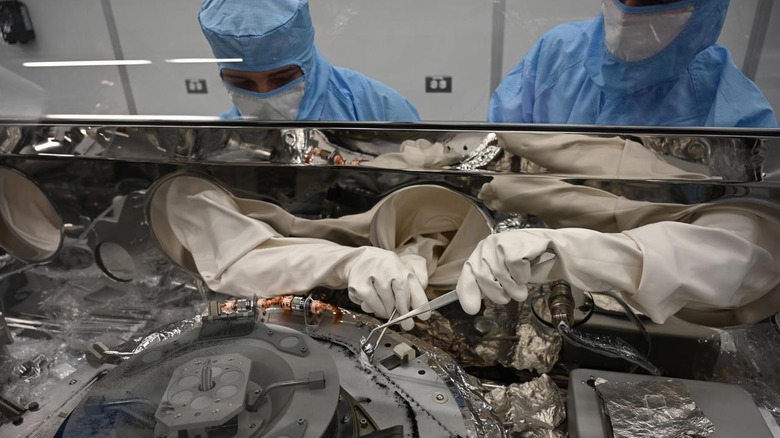These Researchers Finally Managed To Get Their Hands On NASA's First Asteroid Sample
In 2023, NASA made headline news when it returned its first sample from an asteroid. The OSIRIS-REx mission, launched in 2016, traveled away from Earth and toward the asteroid Bennu. It touched down on that asteroid and scooped up a sample of rock and dust from its surface, before turning around and traveling back to Earth.
In September 2023, the OSIRIS-REx spacecraft was approaching Earth. It jettisoned its capsule containing the sample. This capsule traveled through the Earth's atmosphere, slowed by a parachute, and landed in the Utah desert. From there, a team collected it and brought it to NASA's Johnson Space Center, where the capsule could be carefully opened and the sample extracted.
The sample will be shared between NASA and other space agencies like JAXA, the Japanese space agency, which performed its own asteroid sample return missions. The Hayabusa and Hayabusa 2 missions visited the asteroids Itokawa and Ryugu respectively, with Hayabusa 2 collecting a sample from Ryugu and returning it to Earth in 2020, the first time any asteroid sample had been brought back to Earth.
NASA now joins the asteroid sample return history. "Successfully delivering samples from Bennu to Earth is a triumph of collaborative ingenuity and a testament to what we can accomplish when we unite with a common purpose," said Dante Lauretta, principal investigator for OSIRIS-REx, when the sample landed.
"But let's not forget – while this may feel like the end of an incredible chapter, it's truly just the beginning of another. We now have the unprecedented opportunity to analyze these samples and delve deeper into the secrets of our solar system."
A first look
It turned out to be difficult to open up the capsule and get the sample inside. NASA technicians were able to remove the lid from the sample canister without issue on Sept. 25, just a day after the capsule landed on September 24. But then there was a more delicate challenge: opening up the mechanism which had collected the sample, called the Touch and Go Sample Acquisition Mechanism (TAGSAM).
The team wasn't sure exactly how much material it had scooped up from asteroid Bennu. In the end, it turned out that they had more material than expected, and there was a significant amount of material inside of the canister but outside of the TAGSAM. They didn't want to waste any of this extra, so the material outside the TAGSAM was carefully collected and sent off for a first analysis.
"The very best 'problem' to have is that there is so much material, it's taking longer than we expected to collect it," said deputy OSIRIS-REx curation lead Christopher Snead of NASA's Johnson Space Center at the time. "There's a lot of abundant material outside the TAGSAM head that's interesting in its own right. It's really spectacular to have all that material there."
The first analysis of this material showed that there was evidence of both carbon and water in the material, which was exciting as studying asteroids can help scientists to learn about the early stages of the solar system.
Opening it up
The team had to actually open the main sample. To make sure none of the sample was lost, the TAGSAM was placed into a container called a glovebox. This is a sealed box in which curators can only interact with the things inside using gloves from the outside and particular tools which won't cause any damage to the sample.
Opening the TAGSAM inside the glove box proved difficult. The team were able to open up the head of the sampler and get 70 grams of sample in total, by far the largest asteroid sample brought to Earth to date. The team did this by accessing the sample through the head's mylar flap.
There was more of the sample inside the TAGSAM, but it was hard to access, as disassembling the TAGSAM was tricky. There were two of 25 fasteners used inside the TAGSAM to hold it together which they couldn't open with the tools available. The team had to take several months to develop and custom-make new tools which could operate safely inside the glovebox and remove the fasteners.
In January 2024, they were able to remove the last two fasteners, which should enable the rest of the sample to be removed.
"Finally having the TAGSAM head open and full access to the returned Bennu samples is a monumental achievement that reflects the unwavering dedication and ingenuity of our team," said Lauretta. "This success reaffirms the significance of OSIRIS-REx and our commitment to advancing our understanding of the cosmos. We eagerly anticipate the next chapter as we share these precious samples with the global scientific community and continue our journey of discovery."
How scientists study the sample
When the samples are delivered to laboratories around the world, scientists will be using a variety of tools and instruments to analyze them. As each group might get just a few grams, they need to be very careful with the techniques they use to ensure they aren't destructive.
The University of Arizona, for example, has a facility called the Kuiper-Arizona Laboratory for Astromaterials Analysis, where a portion of the asteroid sample will be studied. The lab has instruments that can look at extremely small scales to make analyses on the atomic level.
"We literally can look at single atoms," said OSIRIS-REx co-investigator Pierre Haenecour. "We also have a nanoscale secondary ion mass spectrometer, or nanoSIMS for short. It allows us to look at isotopes (different variations of atoms) to understand how each particular component in the sample originated."
This group wants to study the sample to learn about the origin of asteroids like Bennu, as well as preserving a portion of the sample for future analysis with more sophisticated instruments. The reason the sample is so interesting is that asteroids are material that is left over from the formation of the planets, but it hasn't been through the same processes that the planets have. Therefore, it is a pristine way to look back billions of years.
"With these samples from Bennu, we now have all the contextual information that will enable us to study these materials at the fundamental levels and tell the story of the origins and history of asteroid Bennu," said University of Arizona professor of planetary science, Tom Zega.


